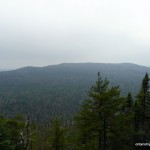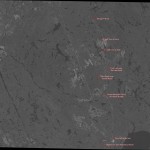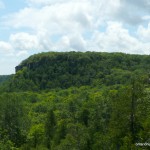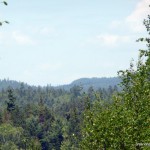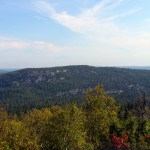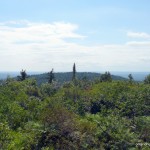Ishpatina Ridge (Tower Summit) – Overland
Posted by Derek on Sep 5, 2010
Rank: 1
Height: 2275 feet / 693 m
GPS recorded height: 2298 feet / 700 m
Lat/Lon: N47 19.002, W80 44.930
Key Col: N49 32.433 W85 35.183 (981ft / 299m)
Clean Prominence: 1293ft / 394m
Summited on (Overland Route): August 1, 2010
Overview:
The Ishpatina Ridge, set in a remote corner of the Lady Evelyn-Smoothwater wilderness park, is a series of worn and rounded bumps spanning approximately 13 km. The Ellis Fire Tower, a lonely sentry and reminder of days of old, sits on the tallest of the bumps and looks out across the vast expanse of Canadian Shield wilderness. At a height of 2275 feet / 693 m, the Ishpatina Ridge is the highest point in Ontario. From a logging road crossing at the Sturgeon River, the Ishpatina Ridge can be climbed in a day by following a series of logging roads, overgrown bush roads, hiking trails and bushwhacks.
Directions:
There are 2 routes to the Ishpatina Ridge:
- The traditional and most common route begins as a multi-day canoe trip up the Montreal River, over a series of lakes and portages between Smoothwater Lake and Scarecrow Lake and ends with a hike up to the summit via an old fire tower watchman’s trail.
- More recently, many hikers have begun to use an overland route accessed via a series of logging roads which are accessed north of Capreol (near Sudbury). Most hikers begin on foot or by bike at a rugged road crossing of the Sturgeon River and follow the road north to a series of overgrown bush trails. Combined with a bushwhack along the west shore of Scarecrow Lake and the usual fire tower trail hike from the trailhead on Scarecrow Lake, many hikers are able to complete the trip from car to car in a long day hike.
Click here for my trip report to Ishpatina Ridge via the Montreal River (traditional canoe route)
Directions to the Ishpatina Ridge via the overland route is as follows:
From the Sudbury area, make your way to Garson either via the Falconbridge Highway (RR-86) or the Garson/Coniston Road (RR-90). Take RR-85 for 18.4 km to Hanmer, and after it jogs across the train tracks follow RR-84 to Capreol which is 6.5 km ahead. Passing through the small town of Capreol, continue along the road for another 8.0 km and then turn right onto Portelance Road. It is 64.4 km from the intersection at Portelance Road to the Sturgeon River, so it would be advisable to make sure you have proper provisions before making the trip. Also, the road may have active logging in progress, so caution is advised — give the logging trucks a lot of space.
The first 5 km of the dirt road is fairly wide and well traveled by the residents of the Wahnapitae First Nation Reserve. The road forks at the Wahnapitae First Nation Reserve sign. Take the left fork and proceed along the road which runs in a north-northeast direction for 15.5 km until meeting up with the Wanapitei River. Do not cross the River at the bridge here, but continue along the west shoreline of the River for another 5.3 km. 20.8 km from the turnoff at the Wahnapitae Reserve, the road crosses the Wanapitei River and follows the eastern shore of the river for another 8.8 km until Stobie Road forks to the right. Cars with low ground clearance will have to be cautious as sometimes the gravel can pile up in the center of the road. Turn right (east) onto Stobie Road and follow the road eastward.
After 5.7 km, the Gervais Road which travels 24 km to the south shore of the Sturgeon River, branches to the left. Following the Gervais Road north, turn left at the forks at 9.2 km and 14.1 km from the intersection with Stobie Road. The final 15 km of road, although quite rough, are still passable for cars as long as caution and common sense are used — drivers should be prepared to drive 20-30 km/h. The Google satellite imagery for the northern half of the Gervais Road is not up to date (as of September 23, 2011) — please see the attached satellite imagery from geobase.ca to see the new extension to Gervais Road.Just before reaching the Sturgeon River, there is a large flat area (old gravel pit) which can easily handle group camping. There is also a smaller campsite right at the river. If camping within 120 meters of the Sturgeon River, a back country pass will be required.
In most situations it should be possible to wade across the Sturgeon River, however strong currents in combination with high water levels can make the crossing hazardous. After crossing the Sturgeon River, stay on the main gravel road north. This road can easily be biked, and if attempting to hike the Ishpatina Ridge and back in a single day, it is recommended to bring a mountain bike for this section.
5.1 km from the Sturgeon, the road fords a small stream which connects Little Scarecrow Lake and Hamlow Lake. However, there is a small makeshift log bridge just east of the road, which crosses the stream. The road skirts the eastern shore of Stull Lake and 1.4 km from the makeshift bridge, an overgrown bush road branches to the right. If on a bike, stash the bike near the intersection here and follow the overgrown bush trail on foot.
Follow the bush path north for about 290 meters and turn east on another bush path which branches to the right. Follow this path eastwards for 570 meters until reaching another fork — take the left fork. The trail past the fork, although marked with flagging tape and blazes, quickly becomes overgrown and passes through some marshy areas. Initially the overgrown trail travels east, but after 0.5 km, the trail turns north. After another 0.5 km, the trail swings right (east) and continues for 0.5 km until terminating. The remaining distance to the Ishpatina trail trailhead on Scarecrow Lake must be bushwhacked. The Ishpatina Ridge Trail trailhead lies 2.5 km (as the crow flies) away from this point. From the end of the bush trail, bushwhack 85 degrees (magnetic north) for 900 meters to the shore of Scarecrow Lake — stay along the southern edge of the hills along the route, as there is no need to climb them. Note: As of September, 2010, the trail has been extended for 1 km to Scarecrow Lake and along the west shore of the lake, cutting the bushwhack to 1.5 km.
If water levels are low on Scarecrow Lake, it may be possible to save time and energy by walking along the rocky shoreline. Occasionally, one will have to swing back into the bush to avoid blow-down and/or marshy areas. There is also a a fairly well established animal path along the lake edge. Once reaching the northwest shore of Scarecrow lake, the bushwhack ends at a well-established campsite and the start trail to the Ishpatina.
The 3.7 km trail to the Ishpatina Ridge – Tower Peak begins at the canoe launch on Scarecrow Lake and ascends through an area regenerating from a recent bush fire — wild raspberries and blueberries are abundant here. The trail skirts a small lake and begins a moderate ascent northwards. About 1.7 km from Scarecrow Lake, the trail passes through a lowland marsh near a second lake along the trail. Logs and wood planks have been layed along the trail to make the passage across easier. Once traversing the marsh, the trail begins to climb more steeply for 0.7 km.
2.4 km from Scarecrow Lake, the trail gains the top of a ridge. This would be the most advantageous place to start the bushwhack to Ishpatina’s South Peak. The trail then descends slightly to Dick Lake, the third and final lake on the route to the summit.
Crossing an overgrown beaver dam at the east edge of Dick Lake, the remaining 1.1 km of trail ascends almost 500 feet to the summit. Closer to the top, the firetower at the summit will come into view. A large boulder hidden by thick bushes at N47.31670 W80.74884, 50 meters from the base of the tower may be the highest point on the summit. At the base of the tower, there are good views towards the North and South peaks.
*Last update: September 23, 2011.
Trip Summary:
00.0 km – Turn onto Portelance Road from RR-84
05.0 km – Turn left at the fork at the Wahnapitae First Nation Reserve sign
20.7 km – Road reaches Wanapitei River, stay on the west shore of the river
25.8 km – Road crosses the Wanapitei River at Fraleck Bridge. Road continues along east shoreline
34.6 km – Turn right onto Stobie Road
40.3 km – Turn left onto Gervais Road
49.5 km – Turn left at the fork
54.4 km – Turn left at the fork
64.4 km – Gravel pit camp near Sturgeon River
00.0 km – Ford Sturgeon River and hike/bike along gravel road
06.7 km – Turn onto overgrown bush road
07.0 km – Turn right onto bush road #2
07.5 km – Take left fork onto overgrown trail
09.0 km – End of the trail, beginning of the bushwhack to Scarecrow Lake
10.1 km – Scarecrow Lake – hike along shoreline to Ishpatina Trailhead
12.3 km – End of bushwhack, beginning of the Ishpatina trail
15.0 km – Ishpatina Ridge – Tower Peak
Moger Pond Peak
Posted by Derek on Aug 18, 2010
Height: 1644 feet / 501 meters
GPS recorded height: 1676 feet / 511 meters
Lat/Lon: N45.1613 W77.3062
Date Summited: July 13, 2010
Directions / Trip Summary:
Moger Pond Peak is the highest point in Lennox and Addington county, just outside of the community of Denbigh.
From Bancroft, travel 55.8 km along Highway 28. Before reaching Denbigh, turn left onto Addington Road which travels north for 500 meters until reaching a dead end / turn around. Park on the northeast side of the turn around and avoid blocking any driveways.
A gated dirt road continues north, just to the left of the Mountain View Farm sign. As the road is on private property — Mountain View Farm, it’s a good idea to ask the owner for permission to cross his land. (As we were departing, we ran into the owner who was curious to our intentions in the area. We explained we were hiking to the highest point in the county just beyond his farm and he said he no problem with us using the road as long as we closed the gates behind us to keep the cows from getting out.)
Past the gate, the dirt road descends towards a lake. The road near the lake may be flooded out and it would be good idea to bring some kind of river shoes or sandals for the water crossings during the trip.
Beyond the flooded trail, you will reach the start of the bushwhack at N45.15720 W77.30915 which is 1.1 km from Addington Road. The bushwhack heads right (east) from the ATV trail through thin underbrush and easily crosses the small creek. Skirting the northern end of a lake, bushwhack north up a notch up the bluff. The climb steepens and the top of is crowned by rocky cliffs, which could be difficult to scramble up. By climbing up through the notch, the scramble is avoided. Near the top of the bluff, you will pass by an interesting rock with ‘appears‘ to be held up by a tree. (From our vantage point the rock was positioned precariously and we decided not to investigate it further).
Once reaching the top of the cliffs, it is a short bushwhack to the summit. The upper elevations of the peak are littered with small rock/moss/low bush covered clearings. The actual high point is on top of a small erratic boulder in the highest of the small clearings. The entire trek one way from car to summit is 1.8 km: 1.1 km of trail hiking and 700 meters of bushwhacking.
Ryan’s Mountain
Posted by Derek on Aug 18, 2010
Height: 1716 feet / 523 meters
GPS recorded height: 1725 feet / 526 meters
Lat/Lon: N45 25.817 W77 18.296
Date Summited: July 11, 2010
Directions / Trip Summary:
Ryan’s Mountain, the highest point in Renfrew County was the site of a Pinetree Line radar base which closed in 1974. The community of Foymount is located along the slopes of the peak, a short distance from the summit. There is no hiking required to ascend this high point, as a road travels right to the top.
Ryan’s Mountain lies 60 km northeast of Bancroft. Make your way to Foymount, eventually ending up on County Road 512. Turn onto Sebastopol Drive which climbs the hill through the community of Foymount. 750 meters from County Road 512, turn left onto Lawrence Road and complete the 300 meter drive to the summit.
Remains of the Pinetree Line radar base buildings as well as towers and their support buildings dot the flattened hilltop. A small hill built around one of the tower cable supports appears to be the highest point.
Hastings County High Point
Posted by Derek on Aug 18, 2010
Height: 1778 feet / 542 meters
GPS recorded height: 1765 feet / 538 meters
Lat/Lon: N45 14.440 W78 07.695
Date Summited: July 11, 2010
Directions / Trip Summary:
Hastings County High Point lies just outside the southeastern edge of Algonquin Park. There are many ATV trails along the route, which starts from the end of the maintained section of Mink Lake Road.
From Bancroft, take Highway 127 north to Lake St. Peter for 34.9 km and turn left (west) onto Mink Lake Road. Follow Mink Lake Road for 11.3 km until reaching a snowplow turnaround area which is a good place to park.
The road beyond this point is rougher and the right turn off onto an ATV trail is only 550 meters ahead. 600 meters from Mink Lake Road, the trail skirts the northeast shore of a small lake, crossing a basic bridge near a beaver dam. The trail runs along the north shore of the lake and becomes more overgrown. 600 meters past the beaver dam, a barely noticeable trail branches to the left which crosses a creek. There are signs of a washed out log bridge here. (If you miss the trail over the creek, the trail swings north and becomes more and more overgrown. Bikers will be able to easily bike in from Mink Lake Road up to this point.)
The trail follows the left shore of the creek but quickly crosses back over to the right side. Barely 300 meters past the first creek crossing, the trail forks. Stay to the right and avoid the washed out bridge crossing to the left.
About 500 meters later, the trail reaches an open area, but the trail keeps right along the edge of the open area, avoiding a small pond directly to the west. Follow the trail for another 250 meters to the bushwhack point. (At this point the trail is not obvious and the forest is fairly easy to pass through, so even though the area is a maze of ATV trails, I found it easiest to bushwhack the last 1 km to the summit).
The bushwhack is through mixed / deciduous forest with open undergrowth, which shouldn’t be a problem for most hikers. There is an ATV trail within 100 meters of the summit, but it’s not obvious where it heads out to. It might provide an alternative route to the peak, avoiding the bushwhack. The summit area is broad, a raised hunting blind is near the highest point.
Muskoka High Point
Posted by Derek on Jul 20, 2010
Height: 1778 feet / 542 meters
GPS recorded height: 1811 feet / 552 meters
Lat/Lon: N45.5075 W78.9351
Date Summited: July 10, 2010
Directions / Trip Summary:
Take Highway 60 east from Huntsville for 12.5 km and turn left onto Limberlost Road. You can take Tally Ho Winter Park Road instead if you miss the intersection like I did to get to Limberlost. Follow Limberlost Road northeast for 18.6 km and turn left onto Tasso Lake Road. Follow Tasso Lake Road north for 2.8 km. The road curves to the east around the north end of Tasso Lake. Just past the dam, you will reach an ATV trail branching to the north. The shoulder of Tasso Lake Road just west of the ATV trail is a good place to park non-ATV vehicles. Note: Some maps indicate Tasso Lake Road branching to the left, 1.8 km past the intersection with Limberlost, however either I wasn’t paying attention or it’s not there, as I don’t recall seeing it.
The ATV trail is easy to follow, but would be too rough for cars to follow. As I was exploring the trails in the area, I decided to bike from Tasso Lake Road to the start of the bushwhack. 1.5 km from Tasso Lake Road, you will depart the main ATV trail and turn left onto a more overgrown ATV path. There are some rough patches as the trail descends towards a creek, crosses it and ascends the other side. About 1.1 km from the left turn (2.6 km from Tasso Lake road), the ATV trail passes by an open area, which I figured was the closest approach to the Muskoka High Point.
Crossing the open area, the bushwhack north begins in a mixed forest with sparse underbrush. After ascending moderately for a couple hundred meters, you will reach the bottom of a steep rise. I didn’t find a notch to ease the ascent, so I climbed straight up it. After scrambling up the rocky cliffs, over fallen trees and gaining the top of the bluff, the trail flattens out. I stopped at the cliff edge and enjoyed the limited views south through the trees. From here it, the bushwhack continues for 0.5 km, ascending moderately through thin underbrush north to the summit area.
As the summit area is fairly flat, there was no obvious high point. A rock I figured to be an erratic was a candidate the for high point, but I concluded that a small rise forming a lip against the north edge of the summit looked higher. A fallen tree marks the spot.
Read the rest of this entry »
Cup and Saucer
Posted by Derek on Jul 17, 2010
Height: 1155 feet / 352 metersGPS recorded height: 1171 feet / 357 meters
Lat/Lon: N45 51.000 W82 06.370
Date Summited: July 19, 2009
Last Updated: September 13, 2014
Directions:
The Cup and Saucer is the highest point on Manitoulin Island. There are 2 ways to get to Manitoulin Island. From Sudbury, take Highway 17 west and turn south onto Highway 6 through Espanola. Continue on Highway 6 for 52 km and cross the swing bridge into Little Current. Continue west on Meredith Street, past the intersection with Manitowaning Street (keep straight), where Highway 6 diverges left and then turn left on Worthington Street where Highway 540 begins. Continue on 540 for 23 km and turn left onto Bidwell Road. The parking lot for the Cup and Saucer trail is a short distance (600 meters) on the right.
The other way to get to Manitoulin Island is via the Ferry from Tobermory, which lies at the tip of the Bruce Peninsula. Once arriving on Manitoulin Island at South Baymouth, take 6 north for 12.4 km until reaching the left turn onto 542. Proceed on 542 for 23.7 km to Mindemoya and turn right onto onto 551 for 11.6 km to West Bay. At West Bay, turn right onto 540 and continue north for 6.5 km at which time Bidwell Road and the parking for the Cup and Saucer Trail will appear on the right.
There are 2 main trails as well as a couple of side ‘adventure’ trails for the Cup and Saucer. The white and blue trails form a 9.9 km loop around the Cup and Saucer formation. The most direct route from the parking lot to the Manitoulin High Point is to take the more scenic white trail up the Cup and Saucer. Shortly past the steep climb up to the East Lookout, a side trail branches to the right and it is a short walk to a small concrete footing which is the highest point along the trail. The highest point on Manitoulin however, is 50 meters southwest off the trail at the coordinates: N45 51.000 W82 06.370. A large tree beside a pile of fallen trees / branches is the most likely location of the highest point. A moss covered boulder 20 feet northeast of the tree is another candidate for highest point.
Peak 546
Posted by Derek on Jul 16, 2010
Height: 1791 feet / 546 meters
GPS recorded height: 1822 feet / 555 meters
Lat/Lon: N45.59546 W78.99214
Date Summited: July 10, 2010
Directions / Trip Summary:
Take Highway 11 north from Huntsville for 20 km and take exit 244 onto Fern Glen Rd towards Emsdale. After 2.7 km, turn right onto 518 and travel 8.2 km to Kearney. In Kearney, turn right onto Rain Lake Road. Follow Rain Lake Road east, which soon becomes a dirt road for 24 km. The road passes by some recently blasted rock piles and makes a 90 degree turn shortly (1.3 km) before coming to a smaller gravel road which is used by ATVs.
Even though the ATV road was in good condition, I opted to park at the intersection and continue on foot. About 1.4 km from the road, a clearing emerges on the left, connecting a rougher logging road which heads southwest. Take this road for 650 meters. At this point, you can begin bushwhack west for 500 meters. The forest in this area is open with very light underbrush. On my way in, I stayed on the road, which eventually loops south and passes just west of the summit, however the more direct route is to bushwhack.
The summit is a fairly flat area with 2 small ridges competing for the highest ground. The area immediately between 2 medium sized boulders appeared to be the highest spot. Trees obscure any possible views.
Read the rest of this entry »
Wolf Lake Mountain
Posted by Derek on Jun 13, 2010
Rank: NA (below 2100 feet)Height: 1654 feet / 504 meters
GPS recorded height: 1650 feet / 503 meters
Lat/Lon: N46 51.759 W80 39.669
Date Summited: May 22, 2010
Overview:
Wolf Lake Mountain is located just outside the boundaries of the world’s largest old-growth red pine forest; the Wolf Lake forest reserve. Named after the lake it stands over, Wolf Lake Mountain is the highest point within the boundaries of the City of Greater Sudbury. The area, commonly referred to as Chiniguichi, is a relatively popular canoeing destination with it’s clear acidified lakes, old growth pine forests and aboriginal pictographs. Read the rest of this entry »
Ishpatina Ridge (North Peak)
Posted by Derek on May 25, 2010
Rank: 3
Height: 2221 feet / 677 m
GPS recorded height: 2247 feet / 685 m
Lat/Lon: N47 19.977, W80 44.014
Line Parent: Ishpatina Ridge (Tower Summit)
Key Col: N47 19.742 W80 44.593 (1640 ft / 500 m)
Clean Prominence: 581ft / 177m
Date Summited: May 1st, 2010
Overview:
The Ishpatina Ridge traverses several rounded humps and under the Ontario 2100 Footer criteria, 3 of these qualify as being distinct 2100+ foot peaks. The familiar Fire Tower summit of the Ishpatina Ridge is the highest point in Ontario and a popular destination. It is reachable via a trail from Scarecrow Lake. The North Peak as seen from the Fire Tower summit appears to be just as high if not higher, but according to Ontario’s Ministry of Natural Resources Ontario Base Maps (OBM) series, it is 43 feet lower. There is no trail to the North Peak of the Ishpatina Ridge and several approaches are hindered by cliffs surrounding the peak.
Ishpatina Ridge (South Peak)
Posted by Derek on Jan 12, 2010
Rank: 5Height: 2188 feet / 667 m
GPS recorded height: 2198 feet / 670 m
Lat/Lon: N47 18.389 W80 45.906
Line Parent: Ishpatina Ridge (Tower Summit)
Key Col: N47 18.704 W80 45.312 (1952ft / 595m)
Clean Prominence: 236ft / 72m
Date Summited: August 1, 2010
Overview:
The Ishpatina Ridge traverses several rounded bumps and under the Ontario 2100 Footer criteria, 3 of these qualify as being distinct 2100+ foot peaks. The highest point, the familiar Tower summit of the Ishpatina Ridge is the highest point in Ontario and a popular hiking and canoeing destination. The South Peak, the lowest of the 3 peaks, ranks as Ontario’s 5th highest point. Despite being only a short bushwhack from the trail leading from Scarecrow Lake to the Ishpatina Ridge Tower summit, the South Peak remains relatively unexplored. A small lake at the summit is crowned by several candidate high points. OBM map spot elevations indicate that the southwestern-most point is the highest.
Directions:
Due to it’s close proximity to the Ishpatina Ridge Trail, the best approach to the South Peak is to hike to it in conjunction with a trip to the main Tower Peak via an overland trip or canoe trip. Although it’s shorter to bushwhack directly to the primary candidate high point from the height of land just south of Dick Lake, the route is made difficult by the extremely thick underbrush which dominates the south slopes of the peak. Instead, it is recommended to bushwhack to the secondary candidate high point first, then bushwhack west around the small lake atop the South Peak to the primary high point, and return back to Dick Lake by retracing the route in.
From the trailhead on Scarecrow Lake, follow the Ishpatina Ridge Trail to Dick Lake. Turn left and follow the lake shoreline west for 250 meters until reaching a small stream at the western edge of the lake. From here bushwhack west and paralleling the stream for about 500 meters to a small lake / wetland. Head northwest around the edge of the lake / wetland area and ascend the hill up to the secondary candidate high point at N47.3088, W80.7612. To get to the primary high point from here, continue the counter-clockwise swing around the lake / wetland by heading west for 250 meters, then south for 500 meters to an open area composed of ferns and moss covered rock outcrops. The height of land at N47.3065, W80.7651 is the likely candidate for the highest point on the South Peak.
Read the rest of this entry »
